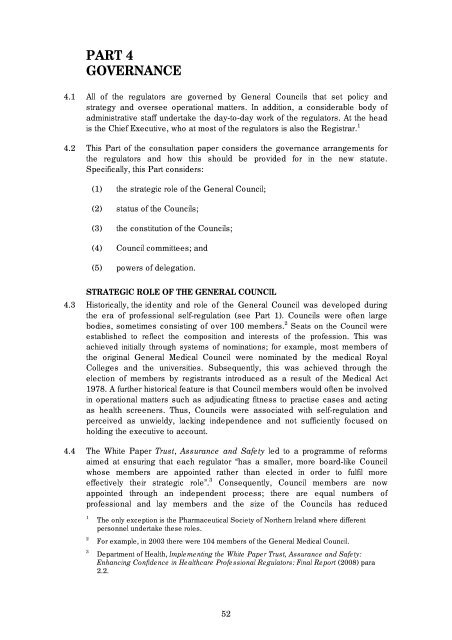Regulation of Health and Social Care Professionals Consultation
Regulation of Health and Social Care Professionals Consultation
Regulation of Health and Social Care Professionals Consultation
You also want an ePaper? Increase the reach of your titles
YUMPU automatically turns print PDFs into web optimized ePapers that Google loves.
PART 4<br />
GOVERNANCE<br />
4.1 All <strong>of</strong> the regulators are governed by General Councils that set policy <strong>and</strong><br />
strategy <strong>and</strong> oversee operational matters. In addition, a considerable body <strong>of</strong><br />
administrative staff undertake the day-to-day work <strong>of</strong> the regulators. At the head<br />
is the Chief Executive, who at most <strong>of</strong> the regulators is also the Registrar. 1<br />
4.2 This Part <strong>of</strong> the consultation paper considers the governance arrangements for<br />
the regulators <strong>and</strong> how this should be provided for in the new statute.<br />
Specifically, this Part considers:<br />
(1) the strategic role <strong>of</strong> the General Council;<br />
(2) status <strong>of</strong> the Councils;<br />
(3) the constitution <strong>of</strong> the Councils;<br />
(4) Council committees; <strong>and</strong><br />
(5) powers <strong>of</strong> delegation.<br />
STRATEGIC ROLE OF THE GENERAL COUNCIL<br />
4.3 Historically, the id entity <strong>and</strong> role <strong>of</strong> the General Council was developed during<br />
the era <strong>of</strong> pr<strong>of</strong>essional self-regulation (see Part 1). Councils were <strong>of</strong>ten large<br />
bodies, sometimes consisting <strong>of</strong> over 100 members. 2 Seats on the Council were<br />
established to reflect the composition <strong>and</strong> interests <strong>of</strong> the pr<strong>of</strong>ession. This was<br />
achieved initially through systems <strong>of</strong> nominations; for example, most members <strong>of</strong><br />
the original General Medical Council were nominated by the medical Royal<br />
Colleges <strong>and</strong> the universities. Subsequently, this was achieved through the<br />
election <strong>of</strong> members by registrants introduced as a result <strong>of</strong> the Medical Act<br />
1978. A further historical feature is that Council members would <strong>of</strong>ten be involved<br />
in operational matters such as adjudicating fitness to practise cases <strong>and</strong> acting<br />
as health screeners. Thus, Councils were associated with self-regulation <strong>and</strong><br />
perceived as unwieldy, lacking independence <strong>and</strong> not sufficiently focused on<br />
holding the executive to account.<br />
4.4 The White Paper Trust, Assurance <strong>and</strong> Safety led to a programme <strong>of</strong> reforms<br />
aimed at ensuring that each regulator “has a smaller, more board-like Council<br />
whose members are appointed rather than elected in order to fulfil more<br />
effectively their strategic role”. 3 Consequently, Council members are now<br />
appointed through an independent process; there are equal numbers <strong>of</strong><br />
pr<strong>of</strong>essional <strong>and</strong> lay members <strong>and</strong> the size <strong>of</strong> the Councils has reduced<br />
1<br />
The only exception is the Pharmaceutical Society <strong>of</strong> Northern Irel<strong>and</strong> where different<br />
personnel undertake these roles.<br />
2 For example, in 2003 there were 104 members <strong>of</strong> the General Medical Council.<br />
3 Department <strong>of</strong> <strong>Health</strong>, Implementing the White Paper Trust, Assurance <strong>and</strong> Safety:<br />
Enhancing Confidence in <strong>Health</strong>care Pr<strong>of</strong>essional Regulators: Final Report (2008) para<br />
2.2.<br />
52
















